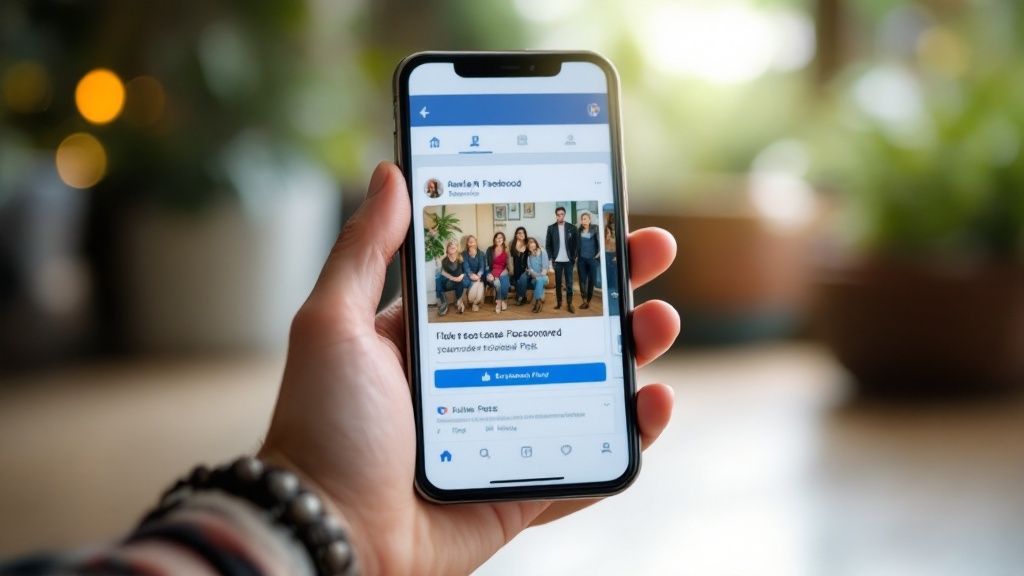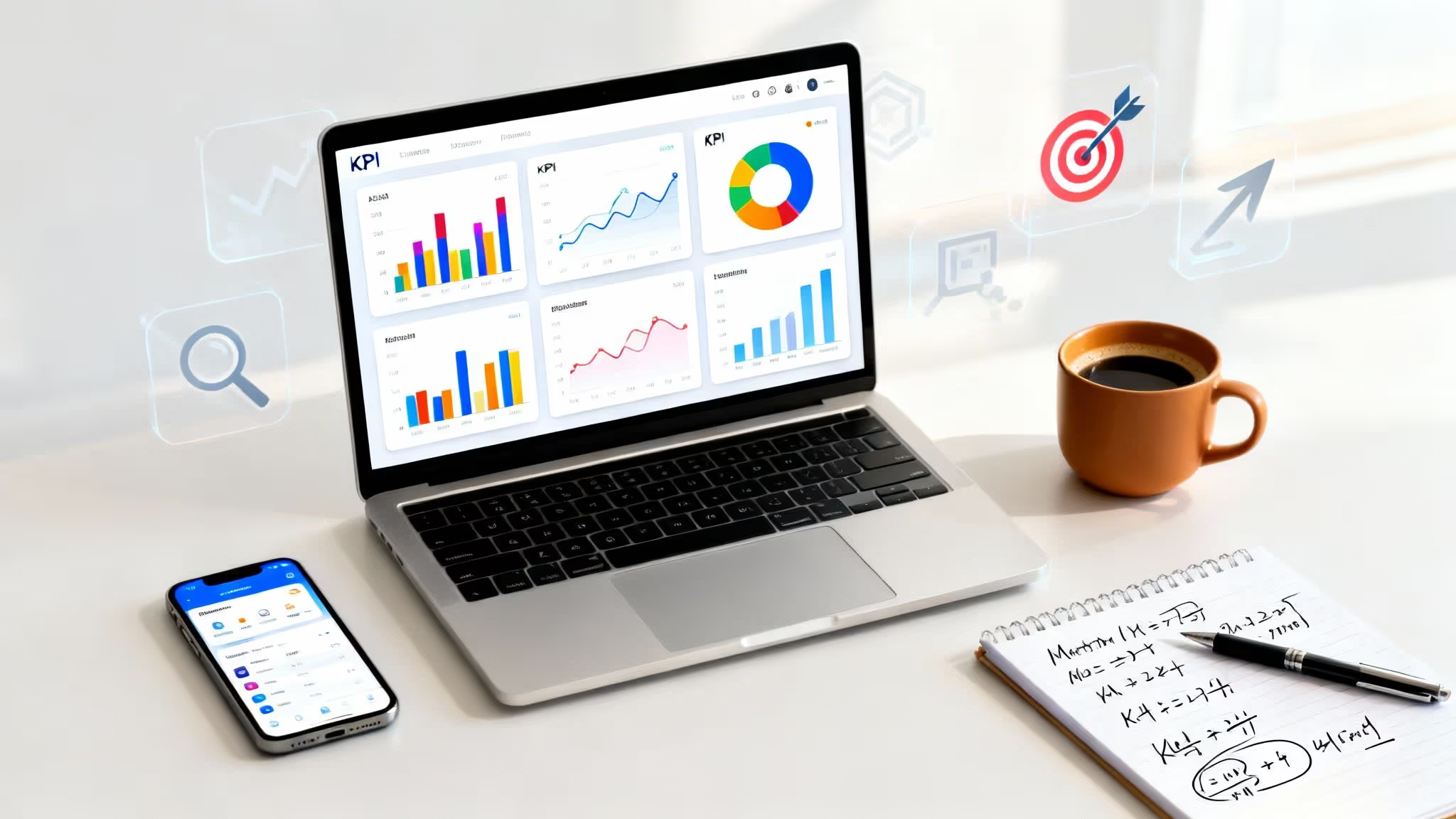At its core, the Facebook advertising platform operates on a massive, real-time auction. But this isn't a typical auction where the highest bid automatically wins. Think of it less like a bidding war and more like a talent show—the ad that wins is the one offering the most value to both the advertiser and the user.
When you launch a campaign, your ad enters a competitive ring where Facebook’s algorithm instantly evaluates it based on your bid, its overall quality, and its relevance to the person who might see it. This dynamic ensures that even small businesses can succeed with highly effective ads.
The Smart Auction Behind Every Facebook Ad

This intelligent auction is what makes Facebook Ads so powerful. It means a small business with a truly compelling ad can outperform a huge competitor that just throws money at the problem with generic content. It’s a system designed to keep users engaged by showing them things they actually care about.
This process delivers powerful results for businesses. Advertisers set their goals—be it brand awareness or direct conversions—and Facebook optimizes ad delivery under a cost-per-click (CPC) or cost-per-impression (CPM) model. For context, the average CPC across all industries on Facebook is around $1.72, but this can vary significantly depending on your niche.
Why Relevance Beats a Big Budget
Facebook’s primary goal is keeping people on its platforms. It achieves this by prioritizing content users find genuinely interesting, which includes the ads they see.
So, how does the algorithm pick a winner? It boils down to three core factors. Understanding these pillars is the first step to making the algorithm work for you, not against you.
The Three Pillars of the Facebook Ad Auction
As you can see, it's the combination of these three factors that determines your ad's total value in the auction. A lower bid paired with a fantastic, highly relevant ad can easily beat a higher bid on a clunky, irrelevant one.
Total Ad Value = (Advertiser Bid) x (Estimated Action Rate) + (Ad Quality & Relevance)
This is the fundamental equation. A high score in action rates and quality can make up for a lower bid, giving savvy advertisers a serious edge.
This auction model has similarities with other ad platforms, but its intense focus on the user experience is what sets it apart. If you’re just getting started with this concept, our guide on paid search advertising offers a great look at how bidding works in a different ecosystem.
Ultimately, getting a real handle on the Facebook ad auction isn't just a technical detail—it's the key to unlocking the platform's incredible potential for growing your business.
Building Your Campaign with the Right Structure
To succeed with Facebook advertising, you must first understand its organizational DNA. Every ad you create is part of a simple but incredibly powerful three-level structure. Mastering this structure isn't just a good idea—it's essential for running efficient, scalable, and manageable campaigns.
Think of it like building a house, where the entire project starts with a single, overarching goal.
The Campaign: Your Overall Blueprint
At the top, you have the Campaign. This is your blueprint, the foundation for everything else. It defines the single, primary objective for every ad set and ad nested underneath it. Are you trying to generate leads? Drive online sales? Build brand awareness? You lock in that one goal here at the campaign level.
A clothing brand dropping a new collection, for example, would likely set its campaign objective to "Sales." This single decision tells Facebook's algorithm to find people most likely to make a purchase. Every other choice you make will be shaped by this core objective. This critical first step aligns every dollar you spend toward a specific, measurable outcome.
The Ad Set: The Rooms in Your House
Next are your Ad Sets, which are like the individual rooms in your house. You can have multiple ad sets within a single campaign, each targeting a different audience or testing a unique strategy. This is where you decide the "who," "where," "when," and "how much."
This is the level where you make key strategic decisions:
- Audience: Who you're trying to reach, based on their demographics, interests, and online behavior.
- Budget: How much you’re willing to spend, set daily or for the lifetime of the ad set.
- Schedule: The start and end dates for when your ads will run.
- Placements: Where your ads will appear—think Facebook Feed, Instagram Stories, Messenger, and more.
By creating different ad sets, you can test which audience best responds to your offer. For instance, you could run one ad set targeting women aged 25-34 who are into yoga, and another for men aged 25-34 who love running, both living under the same "Sales" campaign. For deeper insights into these strategies, it's worth exploring expert paid social services.
The Ad: The Furniture and Decor
Finally, we get to the Ads themselves. These are the creative elements—the furniture and decor you use to fill each room. This is what people actually see: your images, videos, headlines, and calls to action.
The screenshot below shows just how clean and straightforward the interface is for building out these creative assets inside Ads Manager.

This is your playground for experimentation. You can test a dynamic video ad against a sleek carousel ad to see which one gets more clicks from the audience you defined at the ad set level. This layered approach allows you to systematically determine what works without resorting to guesswork.
Reaching Your Ideal Customer with Precision Targeting

This is where the real magic of Facebook advertising happens: the platform's incredible ability to put your business in front of the right people at the right time. We’re moving beyond guesswork into a world where you can build audiences with a level of detail that was once science fiction. Mastering these targeting options is essential for maximizing your return on every dollar spent.
Facebook’s ecosystem is massive. The platform boasts over 3 billion monthly active users, giving advertisers an unparalleled opportunity to reach a staggering 2.28 billion people worldwide with a rich mix of demographic and behavioral data. You can find more details on Facebook's advertising reach at Oberlo.com.
To tap into this power, you need to get familiar with the three main audience types: Core, Custom, and Lookalike audiences.
Core Audiences: The Foundation of Your Targeting
Think of Core Audiences as building your ideal customer from scratch. You use Facebook’s vast data pool to define exactly who you want to reach based on specific criteria. This is your go-to method for finding new customers who have never heard of you before.
You can layer these options for incredible precision:
- Demographics: This includes the basics—age, gender, education, and job title—but also major life events, like targeting people who recently got engaged or had a baby.
- Location: Go as broad as an entire country or as narrow as a single zip code to reach people where they live, work, or are currently traveling.
- Interests: This is powerful. Target people based on the pages they’ve liked, topics they follow, and even apps they use. A fitness brand could target users interested in "yoga," "running," and "healthy eating."
- Behaviors: Target people based on what they do online, such as their purchase history or the type of phone they use. You could even target recent international travelers or small business owners.
Building a solid Core Audience is the first step, but a truly effective strategy means knowing exactly who you're trying to attract. For a deeper dive, check out our guide on how to identify your target audience.
Custom Audiences: Re-Engaging a Warm Audience
While Core Audiences are for finding new faces, Custom Audiences are about reconnecting with people who already know your brand. These are your warmest leads because they've already interacted with you, making them far more likely to take the next step.
Custom Audiences let you turn your existing data into a high-value targeting asset. Instead of shouting into the void, you're speaking directly to people who have already raised their hand.
You can create these powerful audiences from several key sources:
- Website Visitors: Target people who visited your website, viewed specific product pages, or even added an item to their cart and left.
- Customer Lists: Securely upload a list of customer emails or phone numbers, and Facebook will match them to user profiles.
- App Activity: Reach users who have taken specific actions in your mobile app, like completing a level in a game or making an in-app purchase.
- Engagement: Create an audience from people who have watched your videos, liked your Facebook Page, or interacted with your Instagram profile.
Lookalike Audiences: Scaling Your Success
Once you have a high-performing Custom Audience—say, a list of your best customers—you can unlock the final piece of the puzzle: Lookalike Audiences. This is one of Facebook's most potent tools for growth.
The concept is simple but brilliant. You provide Facebook with a "source" audience, and its algorithm analyzes the common traits, interests, and demographics of those users. It then finds millions of new people who share those same characteristics.
This allows you to find highly qualified prospects who are statistically similar to your existing top-tier customers, dramatically boosting your campaign's efficiency and reach.
Managing Your Ad Spend with Budgets and Bids
Once you’ve defined your audience, the next step is managing your budget. Your approach to budgeting and bidding often separates a wildly profitable campaign from a costly one. It all comes down to controlling your costs, either daily or over the long haul.
At the ad set level, you have two main ways to set your budget. Each serves a different strategic purpose, and choosing the right one is key to ensuring your campaign runs smoothly and hits its financial targets.
Daily vs. Lifetime Budgets
Think of a Daily Budget as a steady, predictable allowance. You tell Facebook the maximum amount it can spend each day, making it perfect for "always-on" campaigns where you want a consistent presence. For example, an e-commerce store might set a $50 daily budget to maintain a constant stream of traffic.
A Lifetime Budget, on the other hand, gives the algorithm more freedom. You set a total amount for the entire campaign, and Facebook can choose to spend more on days when it identifies better opportunities. This is ideal for short-term promotions, like a Black Friday sale, where you want to maximize results within a specific window.
Key Takeaway: A Daily Budget offers control and consistency. A Lifetime Budget lets the algorithm chase performance peaks, which can be a game-changer for campaigns with a clear end date.
Choosing Your Bidding Strategy
Your budget sets the spending limit, but your bidding strategy tells Facebook how to spend it. This is where you guide the algorithm, telling it what matters most—getting the maximum number of results or hitting a specific cost per action. Understanding the Pay-Per-Click model is crucial here, and you can learn more about why PPC is important for your organization in our deep-dive guide.
Here are the most common bidding strategies and when to use them:
Highest Volume (or Lowest Cost): As Facebook's default setting, this strategy aims to get you the most results possible within your budget. It’s an excellent choice for rapid growth, brand awareness, or generating a high volume of leads, especially if you can handle some fluctuation in your cost per result.
Cost Per Result Goal: This strategy puts you in control. You tell Facebook the average cost you’re willing to pay for a specific outcome, like a purchase or a lead. This is perfect for businesses that need to hit specific profitability targets, as it helps keep costs predictable and your Return on Ad Spend (ROAS) stable.
By carefully matching your budget type with the right bidding strategy, you build a solid financial framework for your campaign. This gives the algorithm the direction it needs to work efficiently toward your business goals and is absolutely central to scaling your ads profitably.
How Facebook Learns to Optimize Your Ad Delivery

The moment you publish a new campaign, you're handing the keys over to Facebook's powerful machine learning algorithm. This immediately kicks off the learning phase, a crucial period where the system figures out the best way to deliver your ads. Think of it as a new hire's first week; it needs time to learn the ropes before becoming a top performer.
During this phase, the algorithm tests your ad with different segments of your target audience. It analyzes who clicks, who converts, and who scrolls by, gathering thousands of data points to build a profile of your ideal customer. It typically needs about 50 conversions to gain a solid understanding. The initial fluctuation in your cost-per-result is the system spending a little money to gain a lot of knowledge.
This isn't random guesswork. The algorithm is on a mission to find the most efficient and effective opportunities to achieve your desired results.
Crucial Insight: The learning phase is the foundation of your campaign's long-term success. Be cautious with major edits. Changing your targeting, creative, or optimization event can reset the learning phase, forcing the algorithm to start over from scratch.
Guiding the Algorithm with the Right Goal
Your optimization event is the single most important instruction you can give the algorithm. It’s you, telling Facebook exactly what a "win" looks like for your business.
Choosing 'Add to Cart' trains the algorithm to find people who browse and add items to their cart. But choosing 'Purchase' trains it to find people who pull out their credit cards and complete the checkout. These are two very different types of users. If sales are your goal, you must optimize for purchases.
This simple choice gives the algorithm a clear target, which dramatically improves the quality of the results it delivers.
Choosing Your Campaign Optimization Event
Picking the right optimization event is like giving your campaign a compass; it must point directly at your business objective. Here’s a quick breakdown of common events and their best use cases.
Aligning your chosen event with your ultimate goal is non-negotiable for getting the algorithm to work for you.
Why Ad Quality and Feedback Matter
Beyond conversions, Facebook's algorithm watches how people react to your ads. Positive feedback—likes, comments, and shares—signals that your content is high-quality and relevant. The algorithm rewards this.
Conversely, negative feedback is a major red flag. When users hide or report your ad, they're signaling a poor experience, which directly hurts your performance.
High-quality ads are rewarded with lower costs and better placement in the auction, while low-quality ads are penalized. The system is designed to protect its users, which ultimately helps advertisers who focus on providing real value.
Measuring Performance with the Right Metrics
Alright, your campaigns are live, and the Facebook algorithm is working. Now what? Your job shifts from setup to analysis. Successful advertising is driven by data, not guesswork.
Facebook Ads Manager provides a vast amount of data, and it’s easy to get lost. Understanding how Facebook advertising really works means cutting through the noise and focusing on the few metrics that indicate whether your campaigns are healthy or on life support.
Moving Beyond Vanity Metrics
A common mistake new advertisers make is obsessing over vanity metrics. Metrics like clicks, impressions, and even a high Click-Through Rate (CTR) can feel reassuring, but they don't pay the bills. A great CTR is meaningless if those clicks don't convert into sales. A low Cost Per Click (CPC) seems efficient, but not if it's just paying for traffic that leaves your site immediately.
To get a true measure of performance, you must tie your analysis directly to your campaign's goal. Here’s what actually matters:
- Cost Per Result: This is your north star. It tells you exactly how much you’re spending to get the action you care about, whether that's a lead, a purchase, or a newsletter signup.
- Conversion Rate: This metric reveals the percentage of people who take your desired action after clicking an ad. A low conversion rate is a huge red flag indicating a disconnect between your ad's promise and your landing page's delivery.
- Frequency: This shows the average number of times one person has seen your ad. Keep a close eye on this. As it creeps up (usually past 3-4), you risk ad fatigue. People get tired of seeing the same ad, and your performance will decline.
The Most Important Metric of All
When all is said and done, one metric stands above the rest for most businesses: Return On Ad Spend (ROAS).
This is the bottom line. It’s a simple calculation that tells you how much revenue you’re making for every dollar you spend on ads. It is the ultimate measure of whether your advertising is a profitable investment or just an expense.
A positive ROAS is the clearest signal that your advertising is directly contributing to your business's growth. It answers the fundamental question every business owner asks: "Is this actually working?"
Calculating ROAS is simple, but knowing what a "good" ROAS is and how to improve it separates the pros from the amateurs. To get you up to speed, our guide on how to calculate Return on Ad Spend breaks it all down.
By learning to read your ad reports with confidence and focusing on these key metrics, you can spot problems early, double down on what’s working, and continually refine your strategy for better results.
Have Questions? We Have Answers.
Running Facebook ads can feel like a black box at first. You put money in, but what really happens behind the curtain? Here are some of the most common questions we hear from advertisers just getting their feet wet.
How Long Until My Facebook Ads Actually Start Working?
This is the big one. You've launched your campaign and are now hitting refresh every five minutes. The truth is, Facebook ads need time to find their groove. They typically enter a "learning phase" that lasts about 3-7 days.
During this window, the algorithm works hard, testing your ads on different segments of your audience to figure out who is most likely to convert. While you might see some results trickle in right away, you won't get a true sense of performance until after 1-2 weeks. Patience is key. Avoid making drastic changes during this initial phase, as it can reset the learning process.
Seriously, How Much Should I Be Spending?
There’s no magic number that works for everyone, but a solid starting point for many businesses is $10-$20 per day for each ad set you're running. This gives the algorithm enough budget to gather meaningful data.
However, what’s more important than the dollar amount is giving the system enough data to optimize effectively. The golden rule is to aim for at least 50 conversion events per week for your chosen goal (like purchases or leads). If your budget is too low to hit that number, the algorithm will struggle to learn and improve.
Why Did My Facebook Ad Get Rejected?
It’s a frustrating moment for any advertiser: you’ve crafted the perfect ad, only to have it disapproved. More often than not, it's a simple violation of Facebook's Advertising Policies.
Common culprits include making exaggerated claims ("Lose 30 pounds in 30 days!"), using prohibited imagery like "before and after" photos for health products, or improperly targeting sensitive interests. Before you publish, always give the official policies a quick review and double-check your ad copy, images, and landing page to ensure everything is compliant.
Ready to move beyond guesswork and drive real business growth with your ad campaigns? The experts at Twelverays build data-driven paid social strategies that deliver measurable results. Learn more about our approach and see how we can help you at https://twelverays.agency.





